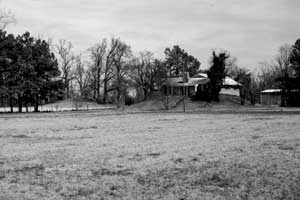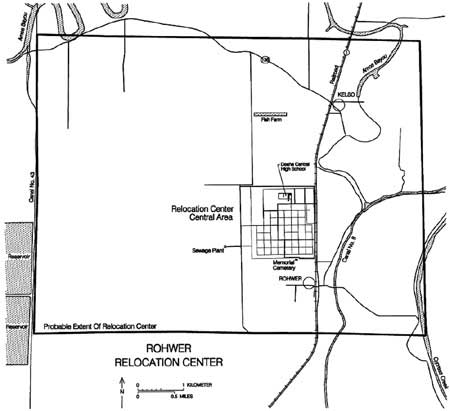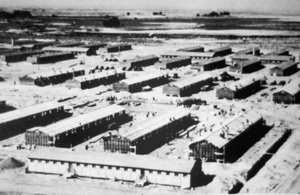MENU
|
| |
Confinement and Ethnicity: An Overview of World War II Japanese American Relocation Sites by J. Burton, M. Farrell, F. Lord, and R. Lord |

|
|
| |
Chapter 11
Rohwer Relocation Center
The Rohwer Relocation Center was located in Desha County, Arkansas, 11 miles north of McGehee and 110 miles southeast of Little Rock. It was one of two relocation centers in Arkansas — 27 miles south was the Jerome Relocation Center. The relocation center was named after the community of Rohwer, which was located one-half mile south.
 Figure 11.1. Residence south of Rohwer on top of a suspected Indian mound (another Indian mound is to the left of the house). |
Several sources indicate the relocation center reserve encompassed 10,161 acres, but a boundary map for the entire reserve could not be located for this report. However, the central area layout plan includes a vicinity map which may provide clues to the boundary. Twenty full sections and four partial sections around the central area are numbered on the map, whereas the other sections depicted on the map are not numbered. While the total area of these sections exceeds the reported 10,161 acre figure, the relocation center reserve was likely limited to lands within these sections (Figure 11.2).
 Figure 11.2. Rohwer Relocation Center. (click image for larger size (~70K) ) |
According to Bearden (1989), half of the relocation center reserve remained under swampy bayou water during the spring. The reserve was mostly on public land meant for subsistence homesteads under the Farm Security Administration; the balance was purchased from local farmers.
 Figure 11.3. Construction underway at the Rohwer Relocation Center. (WRA photograph, National Archives) |
Rosalie Gould, the former Mayor of McGehee, grew up in the area, and recounts that the Arkansas relocation centers were located in very poverty-stricken areas, probably, she believes, at the insistence of some influential Arkansas senator. In spite of local expectations, the centers did not bring prosperity. Hence, as difficult as conditions were within the relocation center, some local residents envied the evacuees' access to regular meals and health care.
 Top
Top
Last Modified: Fri, Sep 1 2000 07:08:48 pm PDT
http://www.cr.nps.gov/history/online_books/anthropology74/ce11.htm
![]()

